Operational Fire Management System (OFMS): A Sensor-Integrated Framework for Enhanced Fireground Situational Awareness
Abstract
1. Introduction
- The system introduces a novel tilt-compensated sensing model that integrates ultrasonic ranging with IMU correction to achieve accurate, real-time water-level estimation in moving fire trucks using lightweight embedded processing.
- It develops a dedicated long-range physiological monitoring and communication network based on LoRa technology, enabling reliable transmission of firefighter vital-sign data in low-connectivity or congested environments.
- OFMS proposes a unified multimodal command-and-control architecture that fuses environmental, physiological, and operational data into a single decision-support interface, enhancing situational awareness, strategic planning, and real-time coordination during firefighting operations.
2. Related Work
2.1. Wearable Physiological Monitoring
2.2. Environmental and Vehicle-Mounted Sensing
2.3. Integrated IoT Frameworks for Emergency Response
3. Methodology
3.1. Communication and Vital Monitoring Subsystem (CVMS)
3.1.1. Handheld Wireless Monitoring Device
3.1.2. Bluetooth Smartwatch for Vital Monitoring
3.2. Monitoring and Environmental Sensing Subsystem (MESS)
3.2.1. Water Level Sensing
Empty Prism Volume ()
Empty Wedge Volume ()
Sensor Calibration
Experimental Validation
- A known volume of water (5.0 Litres) was precisely measured and placed into the tank.
- The tank was manually tilted to numerous compound angles, with the total absolute tilt ranging from 0 to over 20 degrees.
- For each static angle, a semi-automated data acquisition process was initiated using a custom Python (version 3.13.0) script. This process was repeated 10 times per angle to assess the system’s precision.
- Each triggered measurement consisted of a rapid collection of 100 raw sensor samples. To ensure a robust reading free of outliers or noise, these samples were processed on the Arduino using a statistical “modal binning” algorithm. This method identifies the most frequent (modal) value by grouping the samples into 1 mm bins. It then calculates the average of only the readings belonging to that dominant group, yielding a single, stable data point for each measurement.
3.2.2. On-Vehicle Data Processing and Environmental Sensing
3.2.3. Real-Time Tracking
3.2.4. Data Transmission
3.3. Command-and-Control Interface Subsystem (CCIS)
3.3.1. Web Application and Data Integration
3.3.2. Back-End Architecture and Data Processing
4. Results
4.1. CVMS Prototype and Sensor Integration
4.2. MESS Water Level Experimental Results
4.3. CCIS Web-Based Interface and Data Integration
4.4. Power Consumption and Battery Endurance Analysis
5. Discussions
6. Conclusions
Author Contributions
Funding
Data Availability Statement
Acknowledgments
Conflicts of Interest
References
- Yu, P.; Xu, R.; Abramson, M.J.; Li, S.; Guo, Y. Bushfires in Australia: A serious health emergency under climate change. Lancet Planet. Health 2020, 4, e7–e8. [Google Scholar] [CrossRef]
- Illes, C.; Popa, G.N.; Filip, I. Water level control system using PLC and wireless sensors. In Proceedings of the 2013 IEEE 9th International Conference on Computational Cybernetics (ICCC), Tihany, Hungary, 8–10 July 2013; pp. 195–199. [Google Scholar]
- Yuliza, E.; Salam, R.; Amri, I.; Atmajati, E.; Hapidin, D.; Meilano, I.; Munir, M.; Abdullah, M. Characterization of a water level measurement system developed using a commercial submersible pressure transducer. In Proceedings of the 2016 International Conference on Instrumentation, Control and Automation (ICA), Bandung, Indonesia, 29–31 August 2016; pp. 99–102. [Google Scholar]
- Coca, A.; Roberge, R.J.; Williams, W.J.; Landsittel, D.P.; Powell, J.B.; Palmiero, A. Physiological monitoring in firefighter ensembles: Wearable plethysmographic sensor vest versus standard equipment. J. Occup. Environ. Hyg. 2009, 7, 109–114. [Google Scholar] [CrossRef]
- Bustos, D.; Guedes, J.; Santos Baptista, J.; Vaz, M.; Torres Costa, J.; Fernandes, R. Physiological monitoring systems for firefighters (A Short Review). In Occupational and Environmental Safety and Health III; Springer: Cham, Swizerland, 2021; pp. 293–305. [Google Scholar]
- Kozlovszky, M.; Pavlinić, D.Z. Environment and situation monitoring for firefighter teams. In Proceedings of the 2014 IEEE 15th International Symposium on Computational Intelligence and Informatics (CINTI), Budapest, Hungary, 19–21 November 2014; pp. 439–442. [Google Scholar]
- Le, T.; Huerta, M.; Moravec, A.; Cao, H. Wireless passive monitoring of electrocardiogram in firefighters. In Proceedings of the 2018 IEEE International Microwave Biomedical Conference (IMBioC), Philadelphia, PA, USA, 14–15 June 2018; pp. 121–123. [Google Scholar]
- Raj, J.V.; Sarath, T. An IoT based real-time stress detection system for fire-fighters. In Proceedings of the 2019 International Conference on Intelligent Computing and Control Systems (ICCS), Madurai, India, 15–17 May 2019; pp. 354–360. [Google Scholar]
- Pratas, P.; Bustos, D.; Guedes, J.; Mendes, J.; Baptista, J.S.; Vaz, M. Physiological Monitoring Systems for Fatigue Detection Within Firefighters: A Brief Systematic Review. In Occupational and Environmental Safety and Health IV; Springer: Cham, Swizerland, 2022; pp. 469–486. [Google Scholar]
- Scholz, M.; Gordon, D.; Ramirez, L.; Sigg, S.; Dyrks, T.; Beigl, M. A concept for support of firefighter frontline communication. Future Internet 2013, 5, 113–127. [Google Scholar] [CrossRef]
- Yizhe, Z. Design and implementation of firefighter signs monitoring system based on internet of things technology. In Proceedings of the 2021 International Conference on Intelligent Computing, Automation and Systems (ICICAS), Chongqing, China, 29–31 December 2021; pp. 151–154. [Google Scholar]
- Krishnamoorthy, M.; Asif, M.; Kumar, P.P.; Nuvvula, R.S.; Khan, B.; Colak, I. A Design and Development of the Smart Forest Alert Monitoring System Using IoT. J. Sens. 2023, 2023. [Google Scholar] [CrossRef]
- Prakash, C.; Barthwal, A.; Acharya, D. FLOODWALL: A Real-Time Flash Flood Monitoring and Forecasting System Using IoT. IEEE Sens. J. 2022, 23, 787–799. [Google Scholar] [CrossRef]
- Cicioğlu, M.; Calhan, A. Internet of Things-based firefighters for disaster case management. IEEE Sens. J. 2020, 21, 612–619. [Google Scholar] [CrossRef]
- Chehade, S.; Matta, N.; Pothin, J.B.; Cogranne, R. Data interpretation support in rescue operations: Application for French firefighters. In Proceedings of the 2018 IEEE/ACS 15th International Conference on Computer Systems and Applications (AICCSA), Aqaba, Jordan, 28 October–1 November 2018; pp. 1–6. [Google Scholar]
- Kaplan, B.; Li, B. PyroGuardian: An IoT-enabled system for health and location monitoring in high-risk firefighting environments. In Proceedings of the 2025 6th International Conference on Computing, Networks and Internet of Things (CNIOT), Shanghai, China, 23–25 May 2025; pp. 1–11. [Google Scholar]
- Lioliopoulos, P.; Oikonomou, P.; Boulougaris, G.; Kolomvatsos, K. Integrated portable and stationary health impact-monitoring system for firefighters. Sensors 2024, 24, 2273. [Google Scholar] [CrossRef] [PubMed]
- Terzic, J.; Nagarajah, C.; Alamgir, M. Fluid level measurement in dynamic environments using a single ultrasonic sensor and Support Vector Machine (SVM). Sens. Actuators A Phys. 2010, 161, 278–287. [Google Scholar] [CrossRef]
- Sahoo, A.K.; Udgata, S.K. A novel ANN-based adaptive ultrasonic measurement system for accurate water level monitoring. IEEE Trans. Instrum. Meas. 2019, 69, 3359–3369. [Google Scholar] [CrossRef]
- Sengupta, S. IoT-Based Flood Detection and Management Systems in Urban Areas. Risk Assess. Manag. Decis. 2024, 1, 301–313. [Google Scholar]
- Peng, Y.; Xiang, L.; Yang, K.; Jiang, F.; Wang, K.; Wu, D.O. Simac: A semantic-driven integrated multimodal sensing and communication framework. IEEE J. Sel. Areas Commun. 2025. [Google Scholar] [CrossRef]
- Luo, C.; Xiang, L.; Hu, J.; Yang, K. Algorithm Design and Prototype Validation for Reconfigurable Intelligent Sensing Surface: Forward-Only Transmission. arXiv 2025, arXiv:2503.23883. [Google Scholar] [CrossRef]
- Zhao, P.; Hu, D. Private and Effective Range Counting Query Over Evolving Data in Internet of Things. IEEE Trans. Mob. Comput. 2025, 24, 13488–13505. [Google Scholar] [CrossRef]
- Zhao, P.; Wu, J.; Zhang, G. Road Network-Aware and Differentially Private Framework for Location and Location Histogram. IEEE Trans. Intell. Transp. Syst. 2025, 26, 16348–16360. [Google Scholar] [CrossRef]
- Radiocommunications Act. Radiocommunications (Low Interference Potential Devices) Class Licence 2000. 1992. Available online: https://www.legislation.gov.au/C2004A04465/latest/versions (accessed on 29 September 2025).
- Van Laerhoven, K.; Hoelzemann, A.; Pahmeier, I.; Teti, A.; Gabrys, L. Validation of an open-source ambulatory assessment system in support of replicable activity studies. Ger. J. Exerc. Sport Res. 2022, 52, 262–272. [Google Scholar] [CrossRef]
- Arduino AG. Arduino Nano 33 BLE Rev2 User Manual; Arduino AG: Lugano, Switzerland, 2025; SKU: ABX00071. Datasheet modified 29/09/2025. [Google Scholar]
- Adafruit Industries. Monochrome 1.3″ 128 × 64 OLED Graphic Display—STEMMA QT/Qwiic. 2025. Product ID 938. Available online: https://www.adafruit.com/product/938 (accessed on 30 September 2025).
- Seeed Technology Co., Ltd. LoRa-E5 Datasheet V1.0. Seeed Studio, 2020. Available online: https://files.seeedstudio.com/products/317990687/res/LoRa-E5+module+datasheet_V1.0.pdf (accessed on 1 October 2025).
- Adafruit Industries. Bangle.js Hackable Javascript Smart Watch Product Overview. 2022. Available online: https://www.mouser.com/new/adafruit/adafruit-bangle-js-watch/ (accessed on 2 October 2025).
- Hirachan, N.; Mathews, A.; Romero, J.; Rojas, R.F. Measuring cognitive workload using multimodal sensors. In Proceedings of the 2022 44th Annual International Conference of the IEEE Engineering in Medicine & Biology Society (EMBC), Glasgow, UK, 11–15 July 2022; pp. 4921–4924. [Google Scholar]
- Fernandez Rojas, R.; Hirachan, N.; Brown, N.; Waddington, G.; Murtagh, L.; Seymour, B.; Goecke, R. Multimodal physiological sensing for the assessment of acute pain. Front. Pain Res. 2023, 4, 1150264. [Google Scholar] [CrossRef]
- Webber, M.; Rojas, R.F. Human activity recognition with accelerometer and gyroscope: A data fusion approach. IEEE Sens. J. 2021, 21, 16979–16989. [Google Scholar] [CrossRef]
- Kales, S.N.; Soteriades, E.S.; Christoudias, S.G.; Christiani, D.C. Firefighters and on-duty deaths from coronary heart disease: A case control study. Environ. Health 2003, 2, 14. [Google Scholar] [CrossRef]
- Smith, D.L.; Barr, D.A.; Kales, S.N. Extreme sacrifice: Sudden cardiac death in the US Fire Service. Extrem. Physiol. Med. 2013, 2, 6. [Google Scholar] [CrossRef]
- Rajalakshmy, P.; Subha Hency Jose, P.; Rajasekaran, K.; Varun, R.; Sweety Jose, P. A novel sensing technique for continuous monitoring of volume in an automobile fuel tank. In E-Mobility: A New Era in Automotive Technology; Springer: Berlin/Heidelberg, Germany, 2021; pp. 243–257. [Google Scholar]
- Flowline Inc. EchoPod DL24 Multi-Function Ultrasonic Liquid Level Transmitter. 2025. Available online: https://www.flowline.com/product/echopod-dl24-multi-function-ultrasonic-liquid-level-transmitter/ (accessed on 29 July 2025).
- Abbas, N.; Zhang, Y.; Taherkordi, A.; Skeie, T. Mobile edge computing: A survey. IEEE Internet Things J. 2017, 5, 450–465. [Google Scholar] [CrossRef]
- See, Y.C.; Ho, E.X. IoT-based fire safety system using MQTT communication protocol. Int. J. Integr. Eng. 2020, 12, 207–215. [Google Scholar]
- Qiu, M.; Ming, Z.; Wang, J.; Yang, L.T.; Xiang, Y. Enabling cloud computing in emergency management systems. IEEE Cloud Comput. 2014, 1, 60–67. [Google Scholar] [CrossRef]
- Lagunas, E.; Chatzinotas, S.; Ottersten, B. Low-Earth orbit satellite constellations for global communication network connectivity. Nat. Rev. Electr. Eng. 2024, 1, 656–665. [Google Scholar] [CrossRef]
- Shaengchart, Y.; Kraiwanit, T. Starlink satellite project impact on the Internet provider service in emerging economies. Res. Glob. 2023, 6, 100132. [Google Scholar] [CrossRef]
- Damaševičius, R.; Bacanin, N.; Misra, S. From sensors to safety: Internet of Emergency Services (IoES) for emergency response and disaster management. J. Sens. Actuator Networks 2023, 12, 41. [Google Scholar] [CrossRef]
- Su, Y.; Liu, Y.; Zhou, Y.; Yuan, J.; Cao, H.; Shi, J. Broadband LEO satellite communications: Architectures and key technologies. IEEE Wirel. Commun. 2019, 26, 55–61. [Google Scholar] [CrossRef]
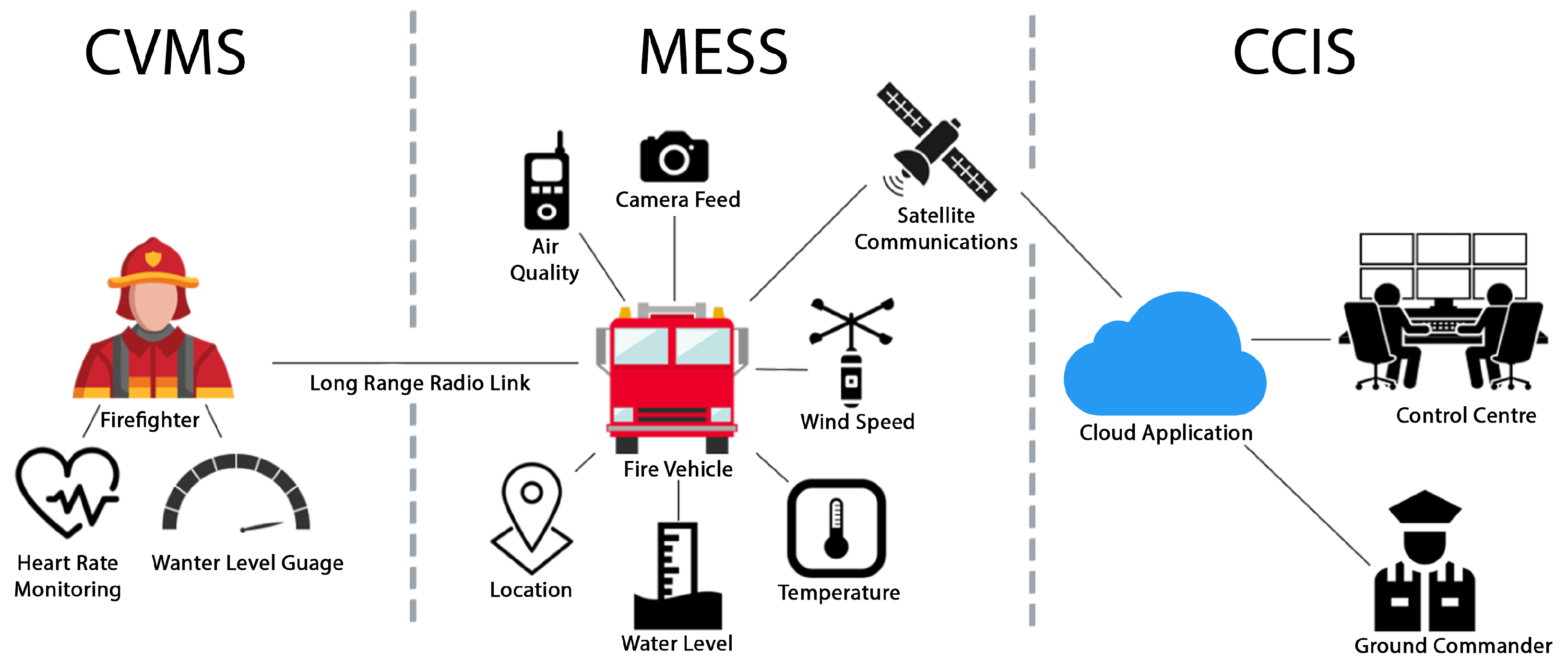
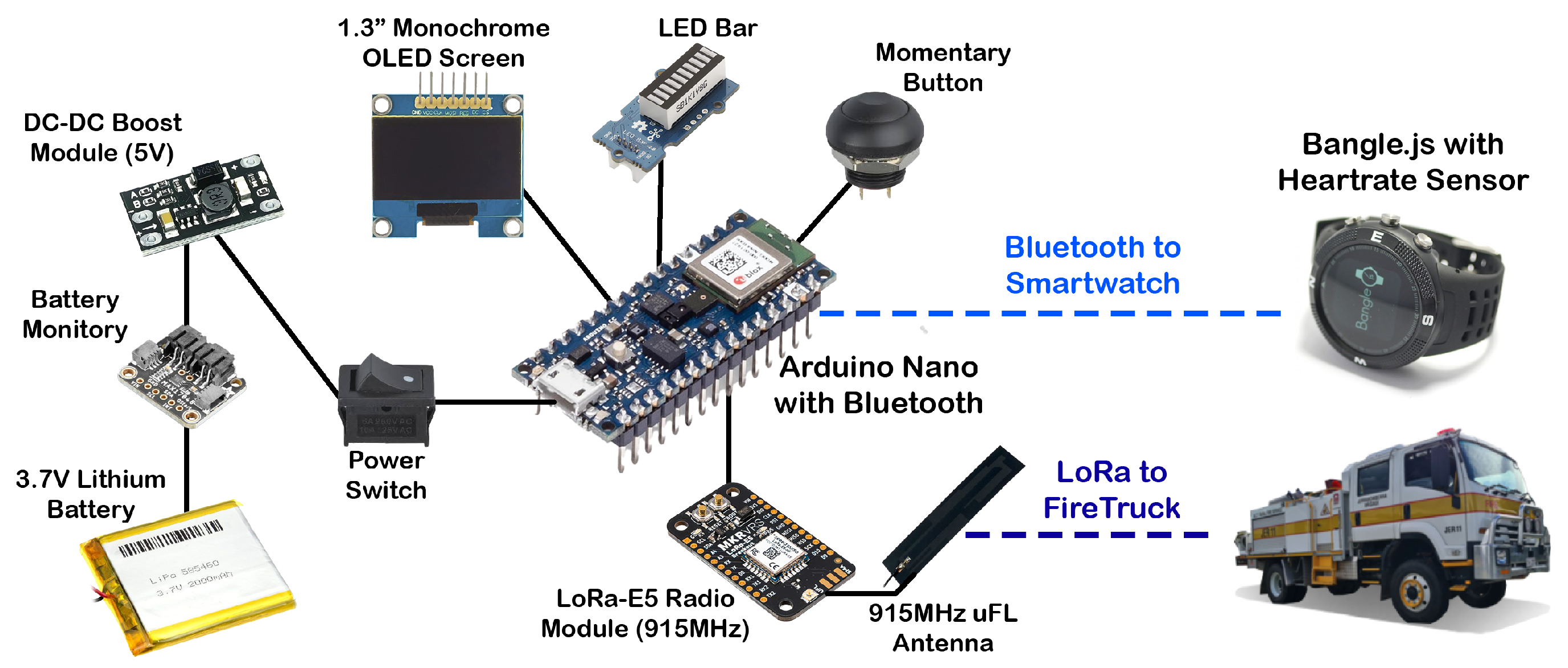
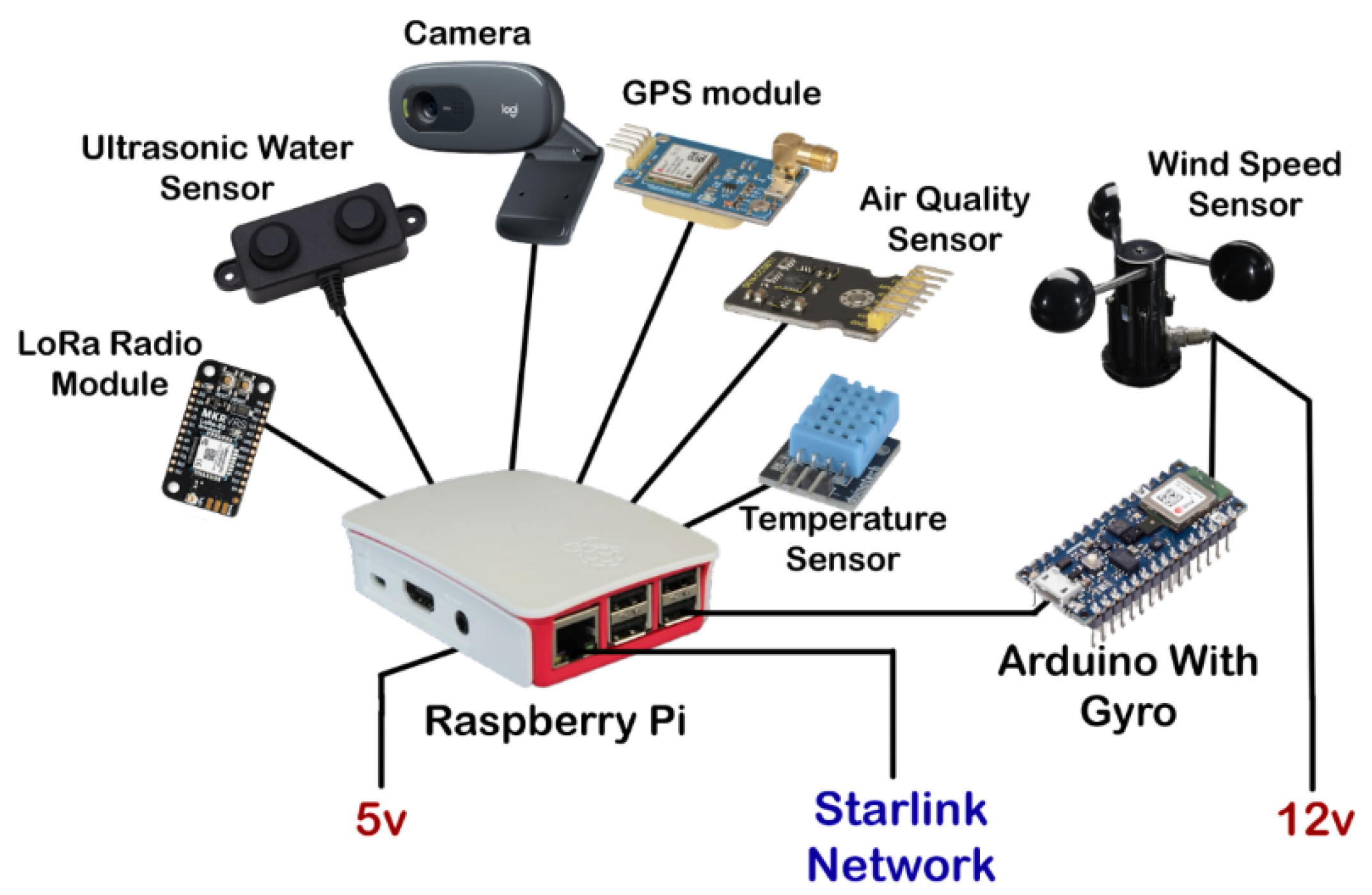
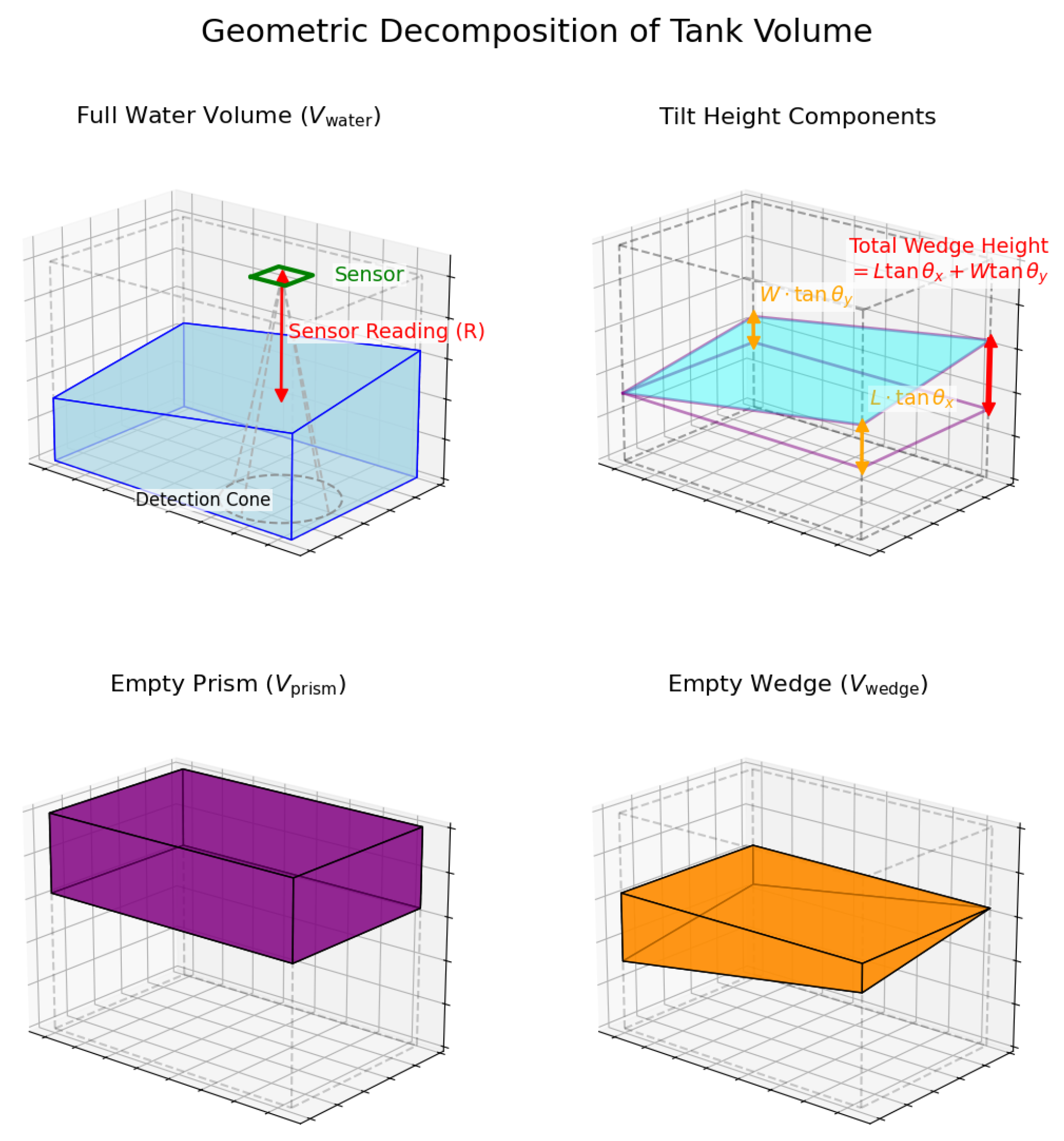

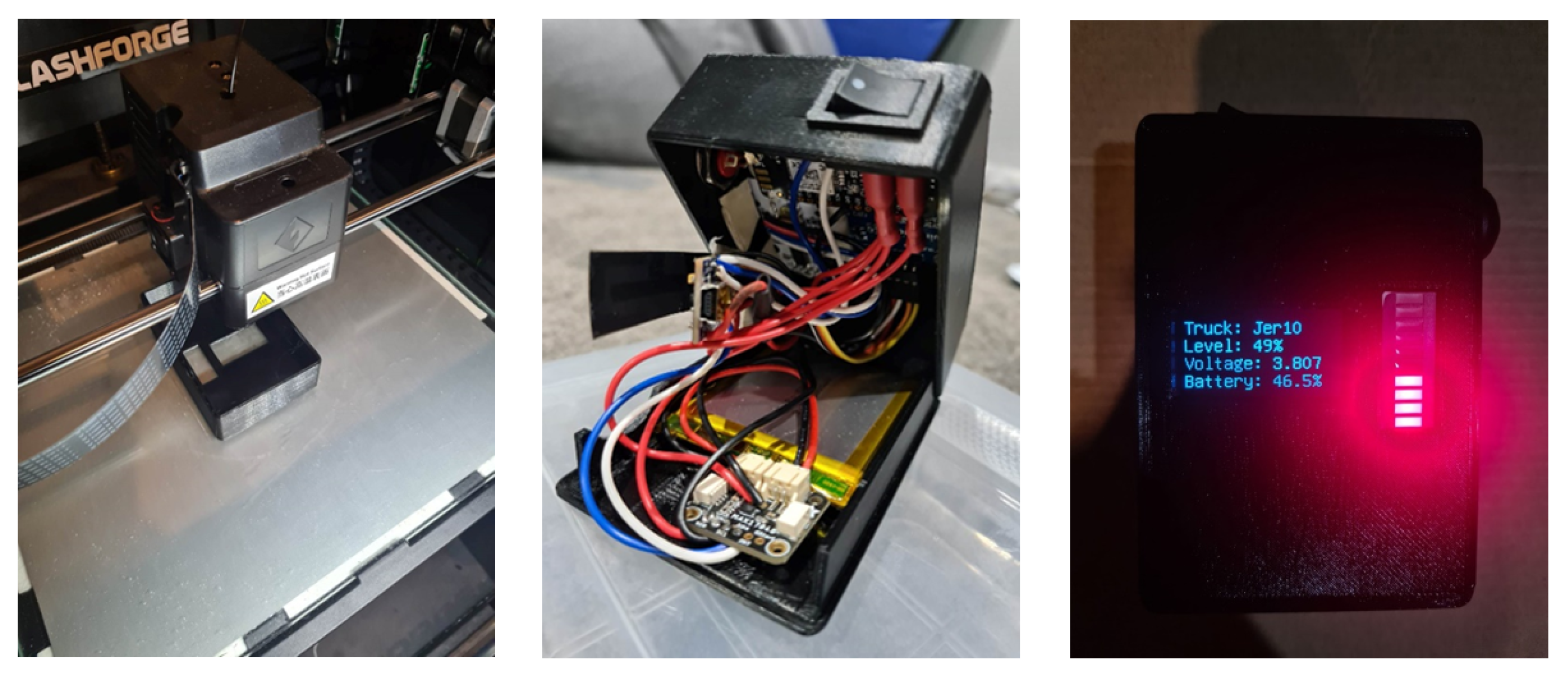
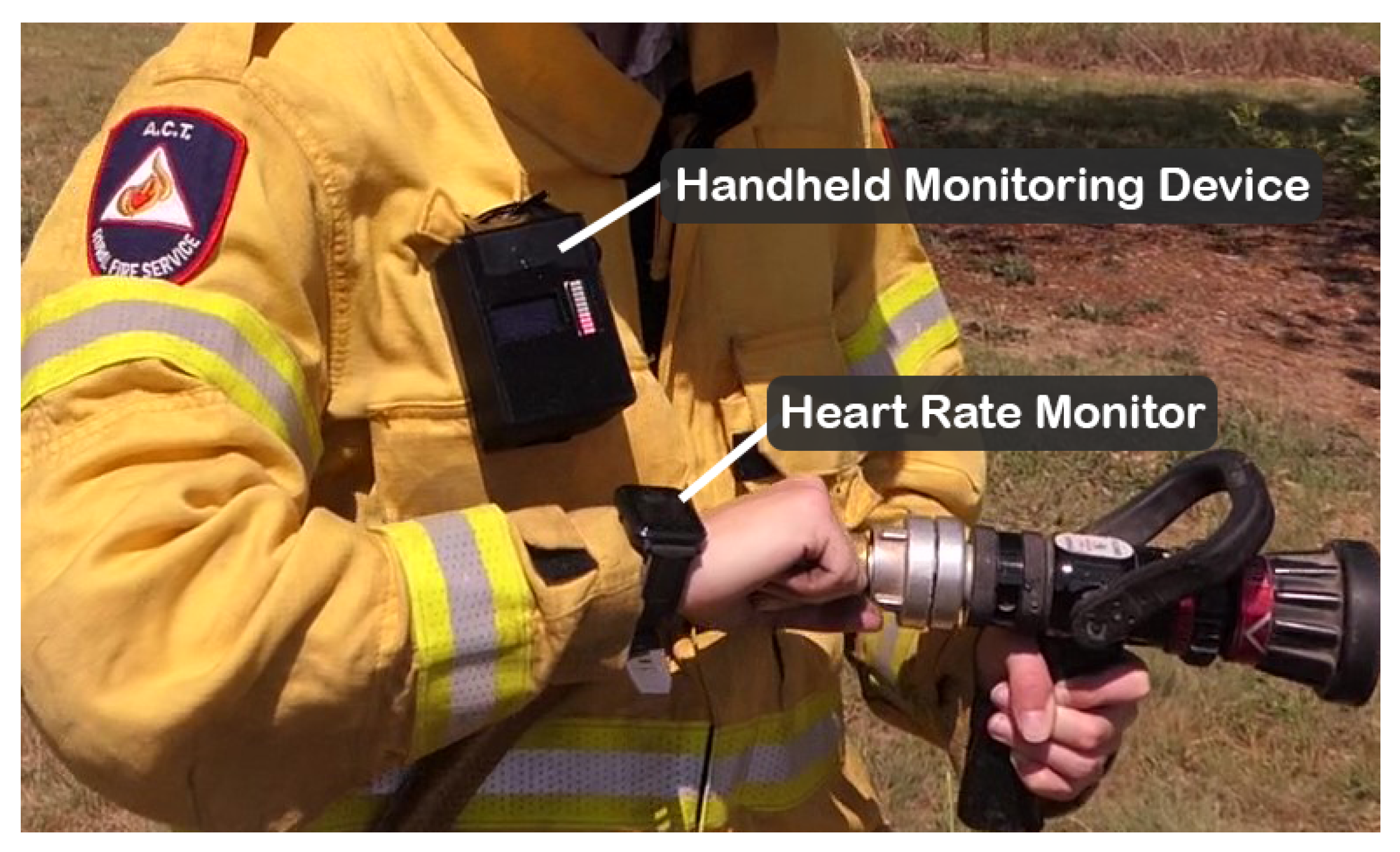



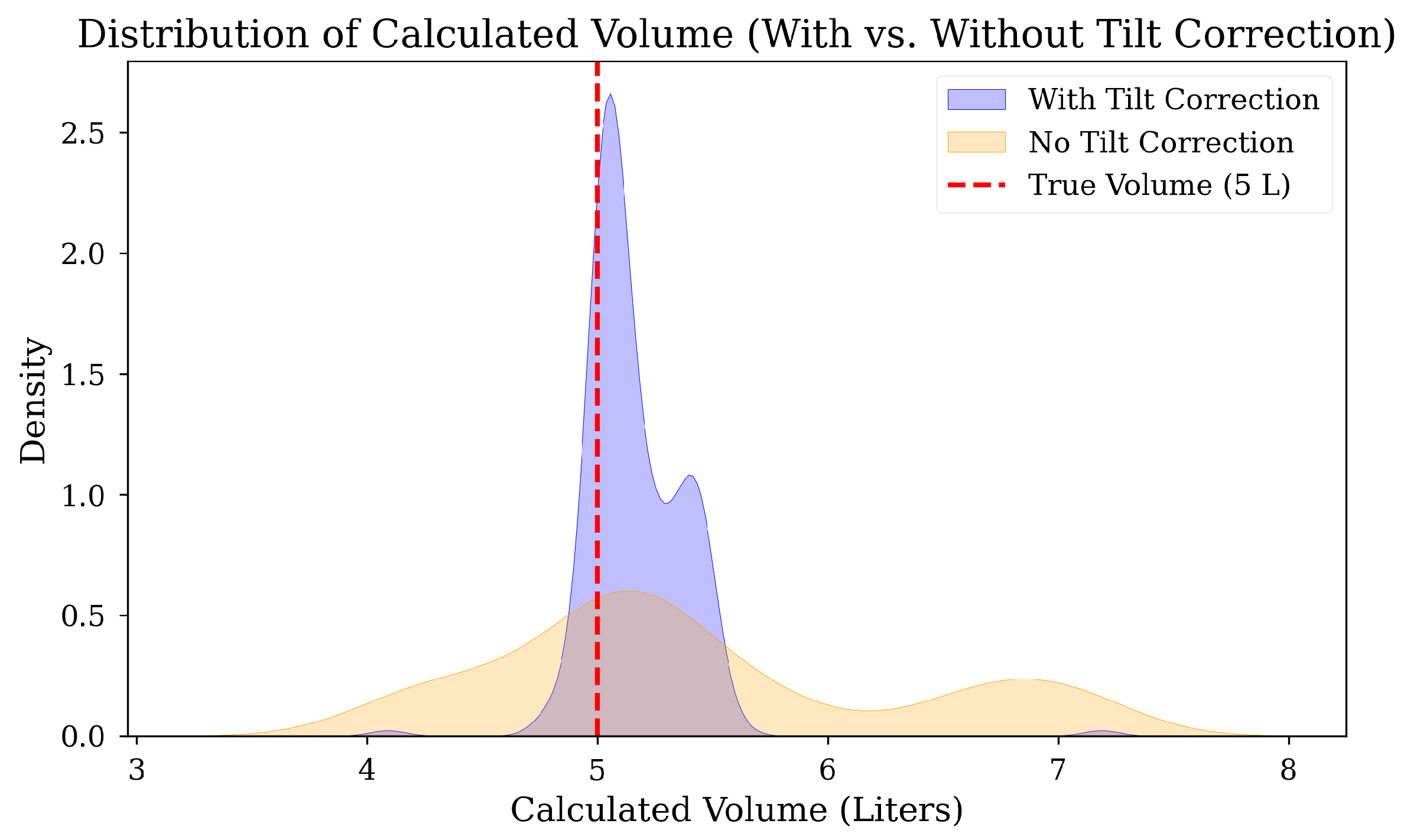
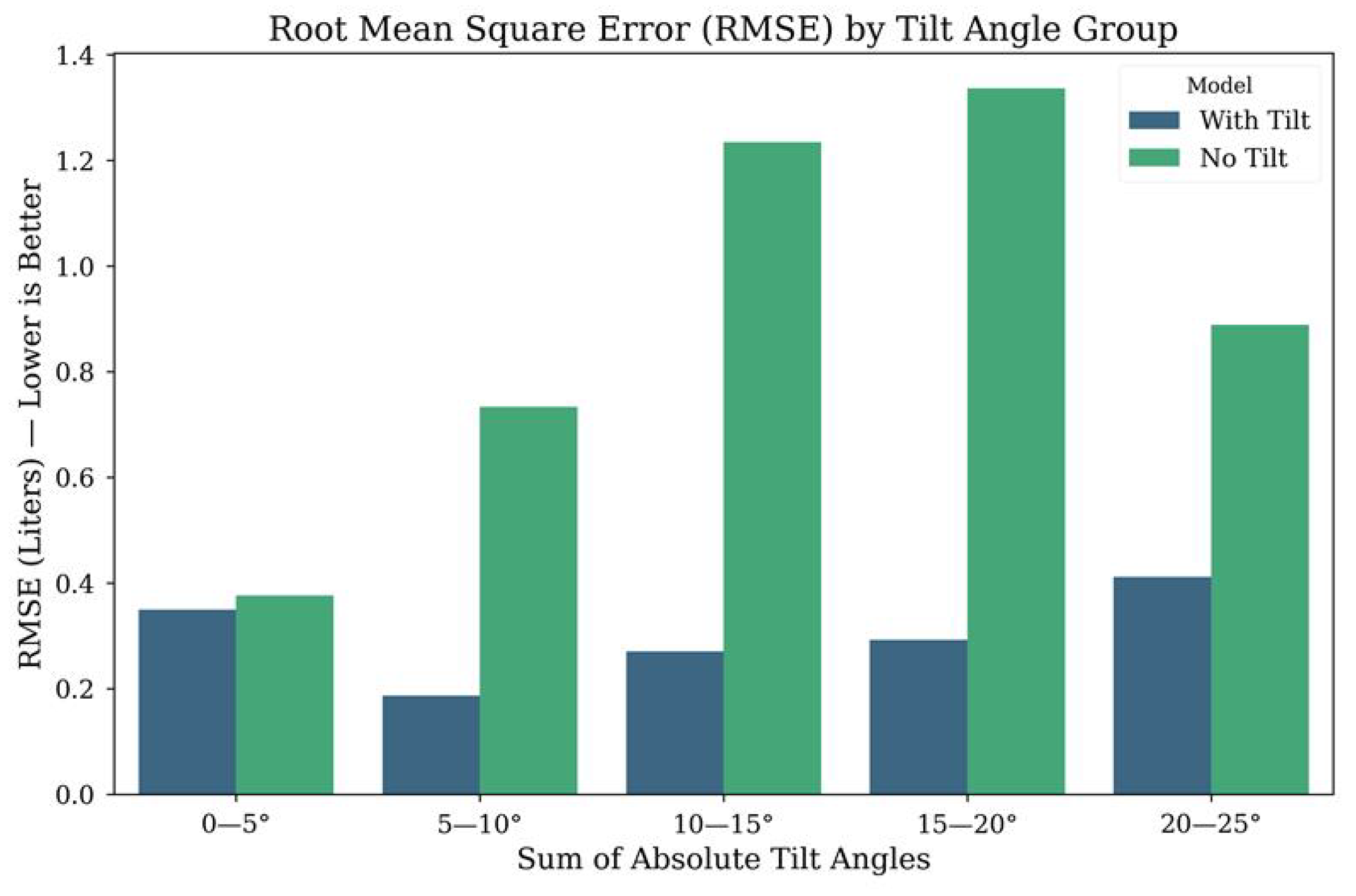
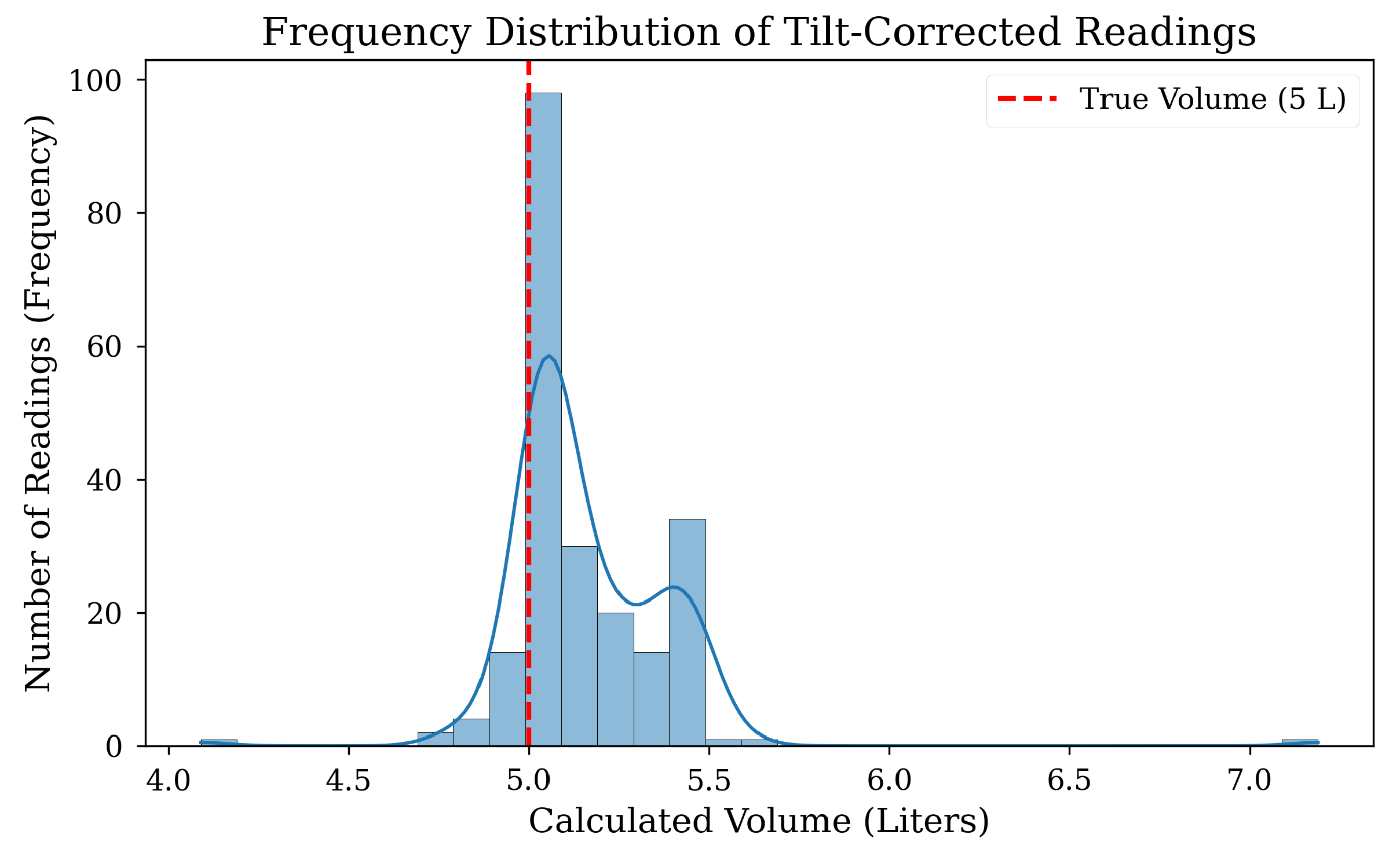

| Dimension | Prior Work | OFMS |
|---|---|---|
| Scope and Integration | Existing studies addressed separate components, wearable monitoring [4,8,17], water-level sensing [2,3,18], or IoT hazard detection [12,13,14,20], without cross-domain integration. | OFMS unifies three interoperable subsystems (MESS, CVMS, CCIS) into a single framework that merges physiological, environmental, and operational data for end-to-end coordination. |
| Water-Level Monitoring Accuracy | Traditional float gauges and static ultrasonic or pressure-based sensors [2,3] fail under vehicle motion; ML-based systems [18,19] improve accuracy but demand high computational resources. | OFMS employs IMU-based tilt estimation and a lightweight modal-binning algorithm to deliver real-time, tilt-corrected measurements deployable on embedded microcontrollers. |
| Physiological Sensing | Wearable solutions such as plethysmographic vests [4] or IoT stress detectors [8] proved feasibility but used proprietary, single-metric devices lacking integration with command systems. | OFMS introduces an open-source smartwatch (Bangle.js) with LoRa connectivity for extensible, replicable physiological monitoring integrated directly with communication and command modules. |
| Situational Awareness Interface | IoT-based disaster systems [12,13,20] provide localised hazard data but lack unified dashboards linking firefighter vitals, vehicle resources, and incident intelligence. | OFMS consolidates all subsystems within an AWS-hosted web interface, enabling commanders to visualise water availability, environmental conditions, and firefighter status in real time. |
| Component | Function | Current Draw |
|---|---|---|
| Arduino Nano 33 BLE | MCU & BLE Radio | ∼12 mA |
| 1.3″ OLED Screen | Active Display | ∼25 mA |
| LoRa-E5 Module | RX/Listen Mode | ∼6.7 mA |
Disclaimer/Publisher’s Note: The statements, opinions and data contained in all publications are solely those of the individual author(s) and contributor(s) and not of MDPI and/or the editor(s). MDPI and/or the editor(s) disclaim responsibility for any injury to people or property resulting from any ideas, methods, instructions or products referred to in the content. |
© 2025 by the authors. Licensee MDPI, Basel, Switzerland. This article is an open access article distributed under the terms and conditions of the Creative Commons Attribution (CC BY) license (https://creativecommons.org/licenses/by/4.0/).
Share and Cite
Kalina, D.; O’Neill, R.; Pevere, E.; Fernandez Rojas, R. Operational Fire Management System (OFMS): A Sensor-Integrated Framework for Enhanced Fireground Situational Awareness. J. Sens. Actuator Netw. 2025, 14, 114. https://doi.org/10.3390/jsan14060114
Kalina D, O’Neill R, Pevere E, Fernandez Rojas R. Operational Fire Management System (OFMS): A Sensor-Integrated Framework for Enhanced Fireground Situational Awareness. Journal of Sensor and Actuator Networks. 2025; 14(6):114. https://doi.org/10.3390/jsan14060114
Chicago/Turabian StyleKalina, David, Ryan O’Neill, Elisa Pevere, and Raul Fernandez Rojas. 2025. "Operational Fire Management System (OFMS): A Sensor-Integrated Framework for Enhanced Fireground Situational Awareness" Journal of Sensor and Actuator Networks 14, no. 6: 114. https://doi.org/10.3390/jsan14060114
APA StyleKalina, D., O’Neill, R., Pevere, E., & Fernandez Rojas, R. (2025). Operational Fire Management System (OFMS): A Sensor-Integrated Framework for Enhanced Fireground Situational Awareness. Journal of Sensor and Actuator Networks, 14(6), 114. https://doi.org/10.3390/jsan14060114








